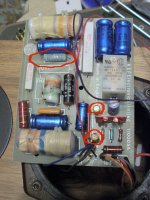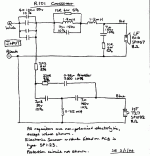for anyone interested I'm going to describe my renewal of the crossovers of these classic speakers which I've had from new.
First, after I removed the 'woofer' to get access to the crossover inside, there is a screw underneath on the outside once remover the crossover was still well attached and I had to lever it off, which was awkward inside the cabinet!, there was four sticky pads holding it there.
The first things I noticed were that the 15R 6W vitreous enamel resistor looked soiled with corrosion(?), a white powdery coating. and two 10v (only!?) caps on the protection circuit had corroded PCB tracks underneath. This was on BOTH crossovers!
I enclose a picture of one of the crossovers
First, after I removed the 'woofer' to get access to the crossover inside, there is a screw underneath on the outside once remover the crossover was still well attached and I had to lever it off, which was awkward inside the cabinet!, there was four sticky pads holding it there.
The first things I noticed were that the 15R 6W vitreous enamel resistor looked soiled with corrosion(?), a white powdery coating. and two 10v (only!?) caps on the protection circuit had corroded PCB tracks underneath. This was on BOTH crossovers!
I enclose a picture of one of the crossovers
Attachments
Hi,
I recently measured the components in a lesser KEF the CODA III however it appears to use the same make of capacitors ALCAP. If yours are anything like mine expect them to be well under value by now.
EG.
marked measured
3.3---------3.1
5-----------4.7
6.6---------5.9
Regards,
Andrew
I recently measured the components in a lesser KEF the CODA III however it appears to use the same make of capacitors ALCAP. If yours are anything like mine expect them to be well under value by now.
EG.
marked measured
3.3---------3.1
5-----------4.7
6.6---------5.9
Regards,
Andrew
Last edited:
I recently measured the components in a lesser KEF the CODA III however it appears to use the same make of capacitors ALCAP. If yours are anything like mine expect them to be well under value by now.
Again for others that's not all, better than, or to make it proper, a matched (caps) pair should give better and more important results. So measured both before install, or the buy 3/4 units mount or use 2 idea must work better also in some cases (when they are not expensive or when you have many).
The very ordinary components in such a quality speaker is quite surprising.
I would replace EVERY component on that board with decent quality modern equivalents.
Ditch the relay too.
I would second that.
dave
I really doubt changing components will make any difference.
ha, ha, ha... elcos alone will have passed their use by date...
dave
I'd agree that the electolytics will be passed their use by dates and recommend replacing them with polyprop's. But, you might find the trebble becomes subjectively a little louder and you might choose to replace the 2R2 padding resistor with a 2R7 resistor.
I recall really enjoying listening to the kef 101 about 15 years ago (in my mis spent youth) so I think you will enjoy upgrading these speakers.
The 4 parallel 100uF caps shown at the input of the crossover are interesting but, assuming this schematic is correct you could probably wire the tweeter network to the positive terminal, rather than the other side of these caps - that might also improve the quality of the trebble.
Nick
I recall really enjoying listening to the kef 101 about 15 years ago (in my mis spent youth) so I think you will enjoy upgrading these speakers.
The 4 parallel 100uF caps shown at the input of the crossover are interesting but, assuming this schematic is correct you could probably wire the tweeter network to the positive terminal, rather than the other side of these caps - that might also improve the quality of the trebble.
Nick
The 4 parallel 100uF caps shown at the input of the crossover are interesting
It would be a worthwhile experiment to see what happens when you jumper these out of circuit. They are a high pass filter, and if one is found to be needed a single smaller high quality cap in front of the amplifier would be much more effective.
dave
It would be a worthwhile experiment to see what happens when you jumper these out of circuit. They are a high pass filter, and if one is found to be needed a single smaller high quality cap in front of the amplifier would be much more effective.
dave
I would expect these caps to increase the apparent bass, I forget exactly how this works, something about combining with the resonance of the driver. You could replace 3 with electros and one with a polyprop to gain some of the benefits of polypropylene without all the cost...
Nick
If changing components buy a new R1=15R/6W resistor, make it 7W or 10W like this resource here Arena Electronics Ltd Resistors
I would go and change the caps on the tweeter C3, C4 and C5 and buy quality ones and maybe, if not enough go with changing caps C1 and C2 for the woofer if the biggest improvement is wanted, but this second option might be up for testing, not sure. http://wduk.worldomain.net/acatalog/SONIQS_PXX_Polypropylene_Capacitors.html
These caps are fact. 5% tol. what is ok by KEF standards (+/-10%) but even that can be a lot. Whenever possible ask for matched pairs of caps, that you have to pay extra.
(The corrosion you mention, I'm leaving that with you, you have to check if it's a lot or not, that needs to be replaced)
I would go and change the caps on the tweeter C3, C4 and C5 and buy quality ones and maybe, if not enough go with changing caps C1 and C2 for the woofer if the biggest improvement is wanted, but this second option might be up for testing, not sure. http://wduk.worldomain.net/acatalog/SONIQS_PXX_Polypropylene_Capacitors.html
These caps are fact. 5% tol. what is ok by KEF standards (+/-10%) but even that can be a lot. Whenever possible ask for matched pairs of caps, that you have to pay extra.
(The corrosion you mention, I'm leaving that with you, you have to check if it's a lot or not, that needs to be replaced)
Last edited:
Re; the 4x100uF caps in series. An earlier post was correct when he suggested an extension of the bass response. As I understand it around that time KEF were using some combination of under damped closed boxes (2nd order) with series high pass caps to produce a damped 3rd order response. I am pretty sure that the KEF 105 (Series I) used 600uF in the same position. The added advantage was that they got a bit of infra-bass filtering and DC protection all in the same package.
Pretty sure that is the explanation. Cheers.
Btw there is a site devoted to KEF stuff. Called "hifispeakers" or hifiloudspeakers". They are good for this sort of thing. Colin Royal seems to be the X-over guru there.
Pretty sure that is the explanation. Cheers.
Btw there is a site devoted to KEF stuff. Called "hifispeakers" or hifiloudspeakers". They are good for this sort of thing. Colin Royal seems to be the X-over guru there.
The KEF B110 SP1003 had Qms=6,7 and the KEF B110 SP1057 driver had Qms=2,44. Do you think that had anything to do with the high value caps, Jonathan?Re; the 4x100uF caps in series. An earlier post was correct when he suggested an extension of the bass response. As I understand it around that time KEF were using some combination of under damped closed boxes (2nd order) with series high pass caps to produce a damped 3rd order response. I am pretty sure that the KEF 105 (Series I) used 600uF in the same position. The added advantage was that they got a bit of infra-bass filtering and DC protection all in the same package.
Pretty sure that is the explanation...
How many liters is the enclosure, do you know dynoPort? (Closed box?) KEF Constructor Series Model CS1 was approx. 8 litres and 81dB/m/W sensitivity, with recomm. amp of cont. 50 watts/channel.
Last edited:
Sorry "inductor" I can't add much to what I have already posted. I think I am recalling stuff I'd read from reviews or from KEF advertising at the time. My maths is not strong with all the "Q" stuff. You may well be right. Another possible explanation is that the boxes were OVER DAMPED and a bit of series resistance increased the Q at the Resonance frequency so giving more bass. Purely speculation at this point......so I better shut up....sorry......Jonathan
I've finished my upgradewith mostly components I already had, some monacor polyprop 6.8uf for the two 7uf
on my 101's there was one 300uf and one 100uf in parallel, I left those they measured ok
they must be to filter high frequencies from the mid/bass driver?
So, how is the sound?
The 300 + 100 uF caps will filter very low frequencies from the mid/bass driver - midrange and trebble is passed through. In effect they transform the bass driver low frequency roll off from second order to third order.
In general this means that below the low cutoff frequency the capacitors change the roll off from 12dB per octave to 18dB per octave but above the cutoff frequency the output response starts to roll off at a lower frequency than the second order filter.
I'm going to have to try this...
Nick
- Home
- Loudspeakers
- Multi-Way
- KEF Reference 101 Loudspeakers. Crossover update

